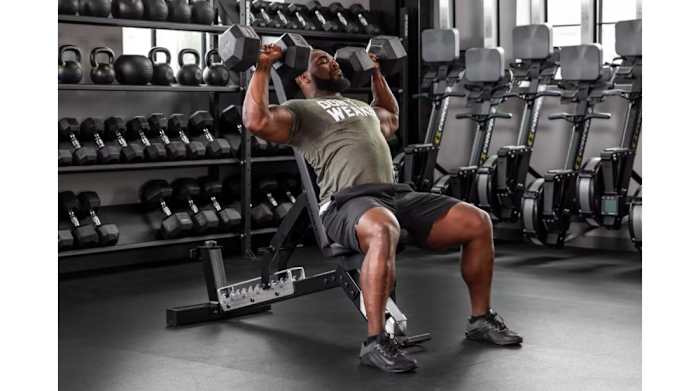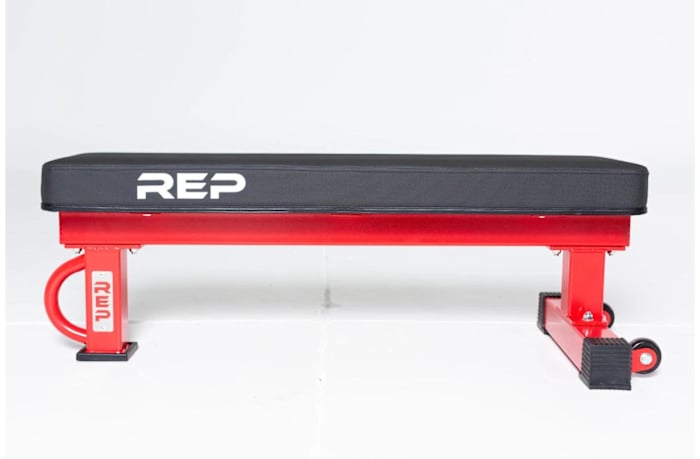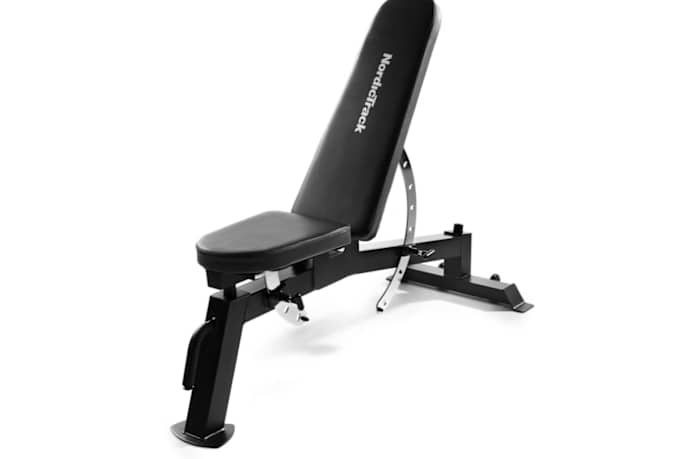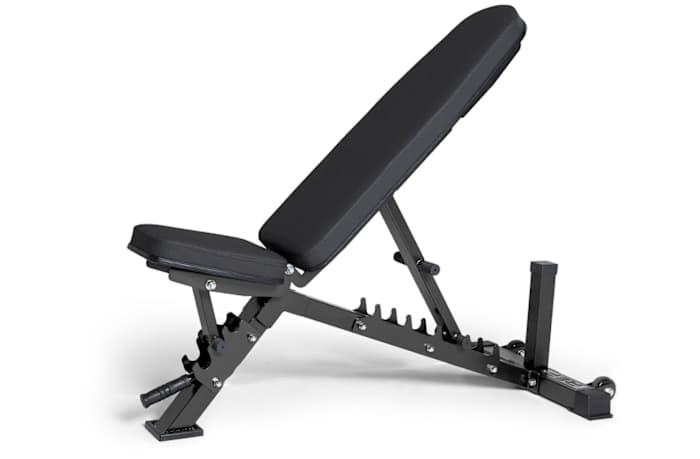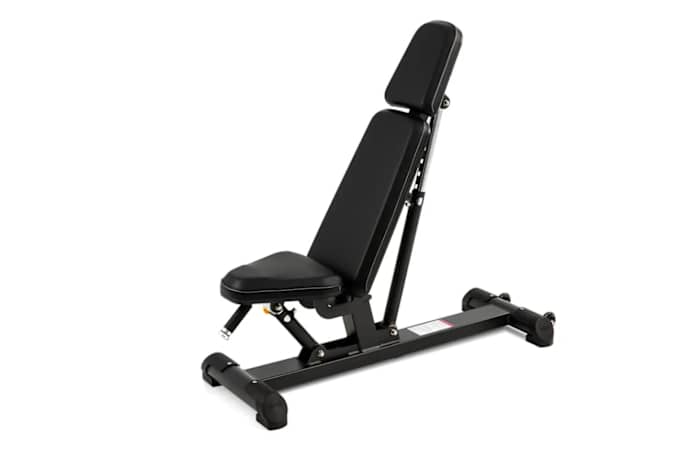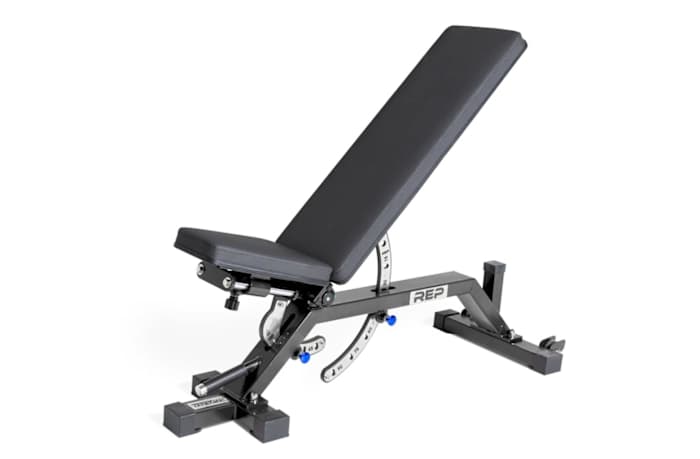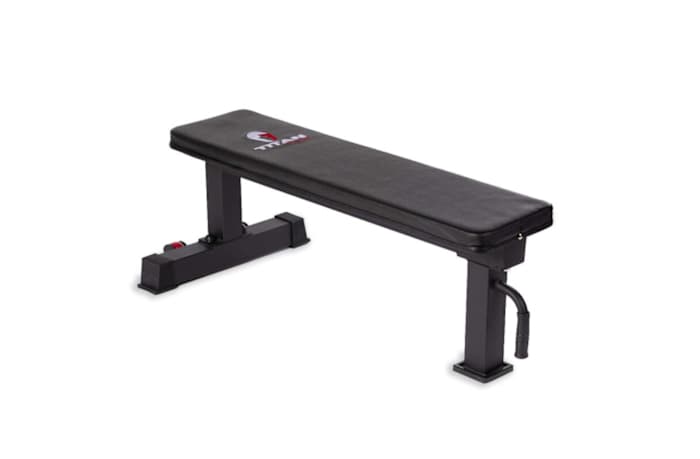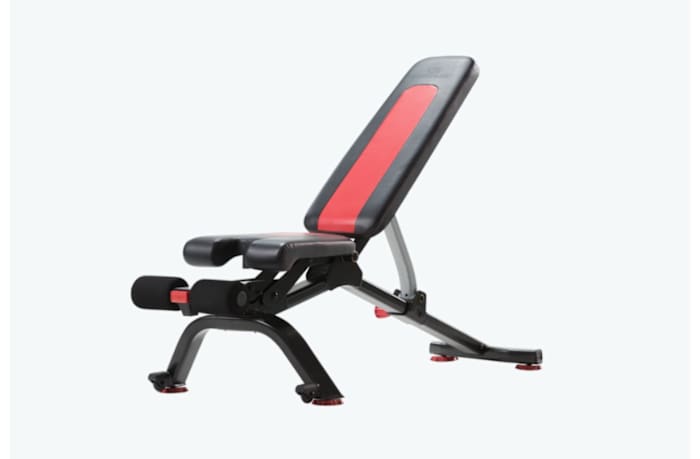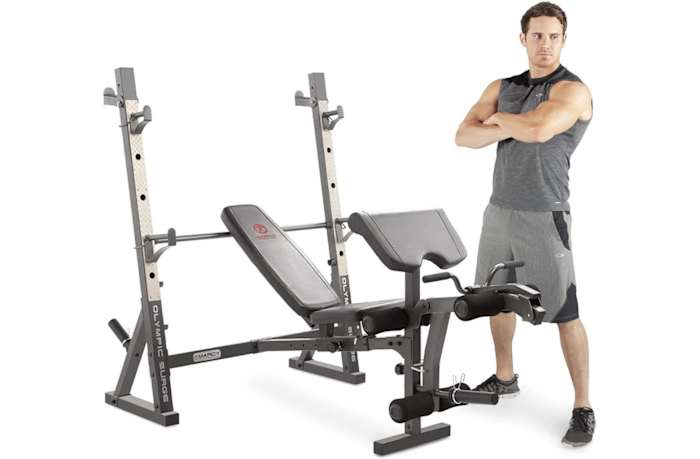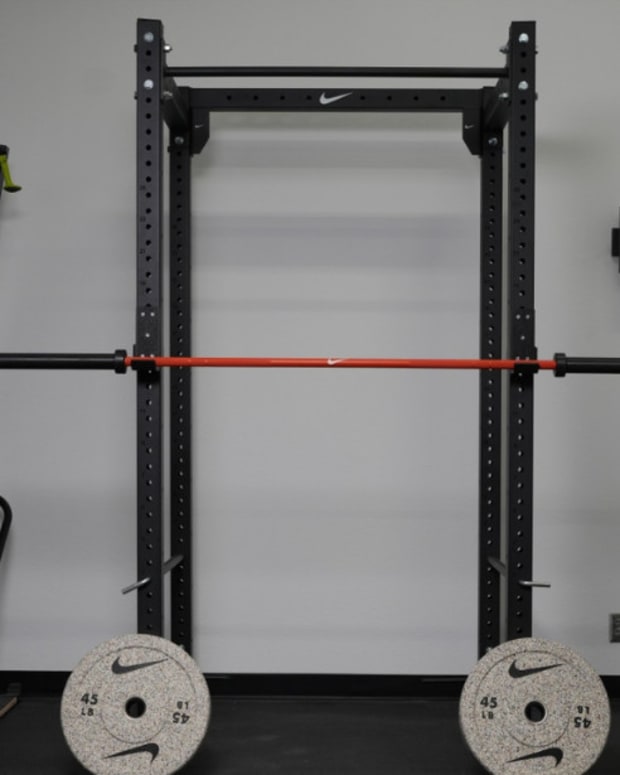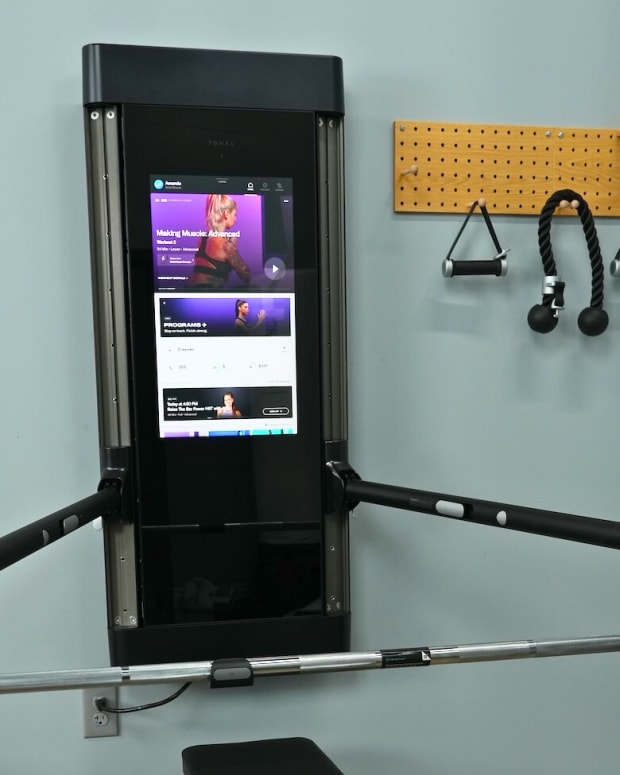The products featured in this article have been independently reviewed. When you buy something through the retail links on this page, we may earn commission at no cost to you, the reader. Sports Illustrated editorial staff are not involved in the creation of this content. Learn more here.
Strength training—a.k.a loading your muscles with extra weight—is arguably one of the best types of exercise for your body. Besides (obviously) making you stronger, it can increase your metabolic rate so you burn more calories throughout the day, lower your risk of injury, improve heart health, help regulate blood sugar levels and can even boost your mood—all of which guarantee a better quality of life.
One of the most fundamental pieces of strength training equipment is a weight bench. Whether you’re using an adjustable weight bench, incline or decline bench or flat bench, you can target muscle groups all over your body with exercises like chest and overhead presses, skullcrushers, rows and more.
The right weight bench for you will depend on how heavy you’re lifting, how much space you have and how versatile your training routine is. These are our top picks for anyone looking to make gains at home in 2024.
Our Picks for the Best Weight Bench of 2024:
- Best Overall Weight Bench: REP Fitness AB-4100 Adjustable Weight Bench
- Best Flat Weight Bench: REP Fitness FB-5000 Competition Flat Bench
- Best Adjustable FID Weight Bench: NordicTrack Workout Bench
- Best Budget Adjustable Weight Bench: REP Fitness AB-3100 Adjustable Weight Bench
- Best Multi-Purpose Weight Bench: Sole Fitness SW116
- Best Luxury Weight Bench: REP Fitness AB-5000 ZeroGap Adjustable Bench
- Best Budget Flat Weight Bench: Titan Fitness Single Post Competition Flat Bench
- Best Stowable Weight Bench: Bowflex 5.1S Stowable Bench
- Best Olympic Weight Bench: Marcy Olympic Weight Bench MD-857
Best Overall Weight Bench: REP Fitness AB-4100 Adjustable Weight Bench
For its price and adjustable features, the REP Fitness AB-4100 is hard to beat. This weight bench easily shifts between seven back positions (ranging from zero to 85 degrees) and three seat positions (zero, 10 and 20 degrees) using a ladder-style system similar to what you’d find on a poolside lounge chair. Weighing in at just 85 pounds, the device isn’t quite as easy to move around as a pool chair, but it’s made from heavy-duty seven- and 14-gauge steel that’s built to support up to 700 pounds. Even at maximum capacity, the grippy vinyl material that covers the foam on the 36-inch backrest and 13-inch seat pad prevents slipping and sliding as you break a sweat.
Pros:
- Comes in seven color options
- Built-in upright post allows for easy storage
- Minimal pad gap, at 1.57 inches
Cons:
- Doesn’t have a decline option
- Requires assembly
Best Flat Weight Bench: REP Fitness FB-5000 Competition Flat Bench
Not everyone needs a bench that inclines and declines, and the simple REP Fitness FB-5000 Competition Flat Bench offers plenty of benefits. Heavy lifters will appreciate the 11-gauge steel tubing and commercial-grade bolts that give this bench a weight capacity of 1,000 pounds—one of the highest on this list. The padding is made from heavy-duty non-slip vinyl and is four inches thick. We love that you can customize the FB-5000 by choosing a 12-inch or 14-inch wide pad, and there are seven color options for the frame.
Pros:
- Small footprint
- Industrial wheels make it easy to move
- Rubber feet to grip and protect the floor
Cons:
- Reviews mention it feels unstable during decentered exercises
- No lifetime warranty on the frame
Best Adjustable FID Weight Bench: NordicTrack Workout Bench
FID (Flat-Incline-Decline) benches give you the flexibility to mix up the angles you plan on working out in, from dumbbell decline press to incline rows. NordicTrack’s Workout Bench has four settings: incline, decline, flat and military. Use the adjustment knobs and backrest bracket to get set up. The bench also features box stitched seats and high density foam in the backrest padding to keep you comfortable as you knock out each rep.
Pros:
- Adjustable; four positions to choose from
- Ergonomic features
- Wheels and handle built in for easy portability
Cons:
- Included exercise log not much of a value add
Best Budget Adjustable Weight Bench: REP Fitness AB-3100 Adjustable Weight Bench
When you’re hauling heavy weights overhead, you don’t want to skimp on a bench that might not be up to the task—but you also don’t have to pay top dollar. The REP Fitness AB-3100 Adjustable Weight Bench provides three seat angle options and six back pad settings, so you can mix up various angles depending on the muscle group you’re targeting. The Carbon Strength bench adjusts to a military, flat or incline setting, depending on what you need. This bench also supports up to 700 pounds and has extra features like wheels for easy moving and rubberized feet to stay firmly in place.
Related Post:
Pros:
- Pad has durable textured vinyl
- Frame comes in metallic black, blue, matte black and red
- Tripod base for optimal foot placement
Cons:
- No decline option
- Does not meet IPF (International Powerlifting Federation) height requirement
Best Multi-Purpose Weight Bench: Sole Fitness SW116
You need a bench that can do it all while you’re putting in the work, which is where the Sole Fitness SW116 can help. You have the option to adjust this bench 14 different ways, with five seat positions and nine backrest options. The sturdy steel frame supports 550 pounds. If you’re looking for ways to get the most out of this bench, you can sign up for a STUDIO membership that will provide you with a wide variety of strength training classes to stream.
Pros:
- Backrest has nine angle adjustment options; the seat has five
- Commercial-grade padding
- 550-pound weight capacity
Cons:
- STUDIO membership costs extra monthly fee
Best Luxury Weight Bench: REP Fitness AB-5000 ZeroGap Adjustable Bench
The REP AB-5000 ZeroGap Adjustable Bench offers the features users need from their bench, making it the best luxury bench on this list. It can support up to 1,000 pounds with its 11-gauge steel construction and incorporates REP’s “Zero Gap” design to keep the seat and back pads together. The seat can reach five angles, ranging from -15 to 45 degrees. The back pad has a seven-angle range, going from a flat bench up to 90 degrees.
Pros:
- Wheels and handle included for easy moving
- 1,000-pound weight capacity
- Offers seven back pad angles and five seat angles
- Five color options to select from
Cons:
- Pricey option
- "Zero Gap" feature isn’t instantaneous
Best Budget Flat Weight Bench: Titan Fitness Single Post Competition Flat Bench
The Titan Fitness Single Post Competition Flat Bench may be cheaper in price, but that’s no dig against the quality. This sturdy model is made from thick, powder-coated steel and supports up to 1,000 pounds. It also features a tripod design—meaning the front foot is a single post rather than two separate feet—which helps with foot placement and leg drive so you can lift with more power. The pad is 2.36 inches thick and is upholstered with durable vinyl that’s easy to clean.
Pros:
- Light, weighing just 37.5 pounds
- Wheels and front handle make it easy to transport
- Easy assembly
Cons:
- No incline or decline options
- Tripod base may become unstable during glute bridges and other decentered exercises
Best Stowable Weight Bench: Bowflex 5.1S Stowable Bench
Another space-saving option, the Bowflex 5.1S Stowable Bench folds up to half its size when you’re not using it and comes with transport wheels that make it easy to move out of sight. When you are ready to lift, you can transition between two seat positions and six different adjustment angles (30, 45, 60 and 90 degrees, flat, and -20 degree decline) using a simple pull-out pin like you’d find on cable machines at the gym. Bowflex is known for the solid construction of its products, and this bench—made from commercial-grade steel and with a load capacity of 600 pounds—is no exception.
Pros:
- Folds to reduce its footprint by more than 50 percent when not in use
- Includes a removable foot pad for stability
- Sturdy and durable
Cons:
- Comes with 15-year warranty
- Large gap between the seat and back pad that shrinks as the incline increases
- Large footprint (61.3” × 28.1” × 49.5”) when in use
Best Olympic Weight Bench: Marcy Olympic Weight Bench - MD-857
Most Olympic benches are two-piece sets, with the bench and barbell rack separate. The Marcy Olympic Weight Bench combines both into one solid, multitasking piece. The steel tube bench handles up to 600 pounds (the bars on the rack hold only 300), and includes an adjustable preacher curl pad for isolated upper body work and a leg developer for lower body training. Use the rack safely when solo thanks to spotter bars, and make sure you’re properly aligned no matter what muscles you’re targeting by adjusting the bench itself through four back positions via a pin-pull system.
Pros:
- Combines rack and bench into one unit
- Spotter bars for safety
- Added features for targeting specific muscle groups
Cons:
- Large footprint (83 inches x 47 inches x 60 inches)
- 600-pound load capacity is lower than other models at this price point
- Barbells and weight plates sold separately
What to Consider When Choosing A Home Gym Weight Bench
Ease of Use
Weight benches use different tools for adjusting the angles, including pins, ladders and locking mechanisms. Ladder systems, like what you’d find on a poolside lounge chair, are incredibly convenient and can handle extremely heavy loads. Pins are very common in gym equipment, but can be a little more difficult to maneuver depending on how high-end the product is.
Choose whichever option will require the least amount of effort on your end; changing the angle of the bench shouldn’t feel like part of the workout. Transport wheels and folding or storage features can also make a bench easier to use at home.
Weight capacity
Benches need to be able to handle a user’s weight and the maximum amount of weight that the user plans to lift. Most quality benches can handle at least 600 pounds—generally 300 for the user and another 300 pounds of additional weight, although you should check the weight capacity breakdown for your specific weight bench. If you’re already on the heavier side—especially if you’re lifting heavy, too—make sure you opt for a bench that can handle higher loads. The more weight capacity a bench has, the higher the price tends to be; that’s because more premium materials are needed to keep the bench stable under stress.
Adjustment options
The more adjustable a bench is, the more exercise options you’ll have. Ideally, the backrest will have a range of motion from flat to 90 degrees, and some benches also decline for certain exercises. Look for benches that have an adjustable seat, as well; if you’re playing with angles, you’ll want to make sure your butt isn’t going to slide on a flat seat before lifting.
Stability
Most benches are made from heavy-duty steel for a reason: When you’re loading them with hundreds of pounds, the last thing you want is a bench that might tip over or scoot out from under you. The heavier the bench, the more rock-solid it will feel during use, although some more affordable benches use a tripod design for stability without adding extra weight. In addition to the materials and design, look at whether or not a bench has rubber foot pads to keep it from slipping (and damaging your floor).
Materials
The majority of weight benches are made from metal, but not all metal is equal. When it comes to steel, the lower the gauge number (generally ranging from three to 30) the thicker it is and the stronger it will be, and steel tubing is stronger than steel pipe. Pay attention to the materials on the padding, too; padding is generally made from foams of differing thickness and density, which will affect your comfort level, and upholstery can be damaged much more easily than the frame.
Warranty
A weight bench can be a big investment, so do your research on a company’s warranty policy. Many benches—even the affordable ones—come with 10 years to a lifetime warranty; there’s no need to choose one guaranteeing the frame for a year or less.
What Are the Benefits of Using A Weight Bench?
Maximum range of motion
To get the most out of any exercise, you need to make sure your joints and muscles can go through the full movement. For example, a floor bench press limits the amount of chest movement compared to a true bench press. On a bench, your feet should be firmly on the ground for stability and power purposes.
Versatility
A bench is great for allowing full range of motion in dumbbell exercises that may be more difficult in a floor or standing position. But you can also use the bench as support for tons of bodyweight exercises like step-ups, split squats, triceps dips and incline pushups.
Best Weight Bench Exercises
Barbell bench press
Lie faceup on a bench with feet flat on the floor and grasp a barbell with an opposing thumb grip (thumbs wraps around the bar) with your hands shoulder-width or slightly wider than shoulder-width apart. Lower the barbell toward your chest, until a slight stretch is felt in the pectorals. Press the barbell back up to the starting position by extending the elbows and contracting the chest.
Biceps curls
Sit with your back against a back rest and place your feet firmly on the floor. Grasp two dumbbells and let your arms hang to your sides, palms facing forward. Keep your feet firmly placed on the floor and slowly bend each elbow in unison, bringing the dumbbells toward your chest. Slowly lower back to start.
Dumbbell rows
Holding a dumbbell in your right hand, bend over to place your left knee and left hand on a bench to support your body weight; make sure your hand is directly under your shoulder and your knees are positioned directly under your hips. Extend your right arm (holding the dumbbell) toward the floor. Exhale and slowly pull the dumbbell upwards, bending your elbow and pulling the dumbbell upwards until you are unable to lift any further without rotating your torso. Inhale and gently lower the dumbbell to your starting position.
Dips
Position yourself just off the edge of the bench with hands shoulder width apart on the edge in good posture and knees at 90 degrees. Slowly lower your body by bending at the elbows and shoulders until your arm at the forearms creates a 90-degree angle, then push back to start.
Hops
Place your hands on the edges of a stable box or bench. Bend at the waist and keep your core tight. Keeping your gaze toward the bench, put a slight bend in your knees. Explosively jump, launching your body to the opposite side of the bench. Land on both feet and check your form. Again, make sure your core is braced. Repeat the movement, gaining speed as you advance.
Step-ups
Stand with feet parallel about hip-width apart while holding dumbbells in your hands with palms facing inward. Slowly step to place your right foot on a bench and push off with the trailing (left) leg to raise your body onto the platform, placing that foot alongside your leading (right) foot. Slowly load the weight of your body into your leading (right) foot and step backward to place the trailing (left) foot on the floor in its starting position. Load your weight into your trailing (left) foot and step off the platform with your leading (right) foot, returning to starting position. Repeat for the opposite side.
Elevated Push-ups
Assume a push-up position with the body in a straight line from head to heel, feet hip- to shoulder-width apart, and hands 1.5-2x shoulder-width elevated on a bench. Lower chest toward the bench through a maximum range of motion until the chest is approximately a few inches off the bench or shoulders have reached elbow depth. Reverse the pattern to return to starting position.
How Much Weight Should I Bench Press?
How much weight you should lift during any exercise will vary significantly depending on your fitness goals, current strength, past injuries and so on. If you’re not sure where to start, you should talk to a certified coach for a personalized fitness plan. No matter what your goals are, it's best to start light—begin with a weight that you can easily bench press for your chosen number of reps (you should feel like the final reps are a challenge, but not like you’re going to drop the weight), and increase gradually. For safety, make sure you have a spotter nearby.
What’s the Difference Between Adjustable Benches and Flat Benches?
Adjustable benches
Adjustable benches allow you to safely perform exercises from a flat, incline, decline and/or seated position. They generally include backrest positions at varying increments between zero and 85 degrees that can be used to make an exercise easier or more challenging. When these benches are flat, there can be a gap between the seat and back pads that may cause discomfort. Adjustable benches also tend to have foot anchors for stability during certain exercises.
Flat benches
Flat benches have an elevated, rectangular platform that’s set parallel to the ground and sits on a supporting frame with two legs. They have less bells and whistles than an adjustable bench, but also have no gap issues and can be more stable than an adjustable bench.
Is a Flat or Incline Bench Better?
Both benches are great at-home options. If you’re someone who lifts really heavy weights, the extra stability of a flat bench might be more stable underneath you. But if you prefer versatility in your strength training, an adjustable bench allows for many more exercises.
What’s the Difference Between Olympic and Standard Weight Benches?
An Olympic weight bench is considered “competition grade” and higher quality than a standard weight bench; it’s meant to support even the highest amounts of weight. You’ll generally find them in commercial gyms, and certainly don’t need one in your own home unless you’re a competitive weightlifter. Standard benches are not competition grade, and are generally those sold for at-home use.
Final Thoughts
Building a home gym can be intimidating, but a good-quality weight bench is an absolute staple. Figure out your budget, decide what type of training you’ll be doing and choose the bench that fits your goals.
Prices are accurate and items in stock as of publish time.
